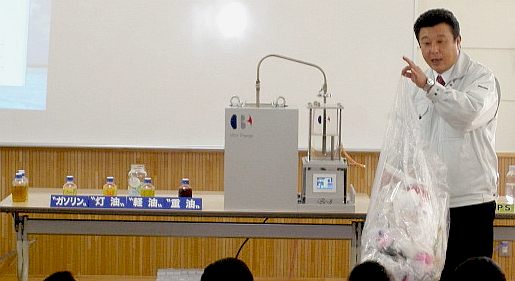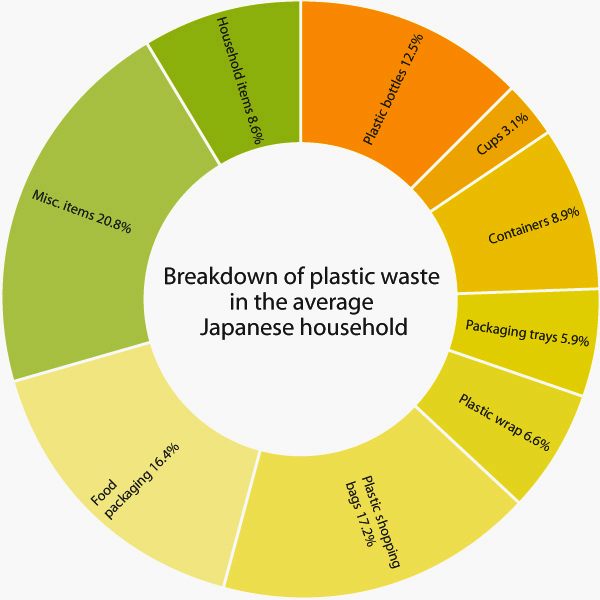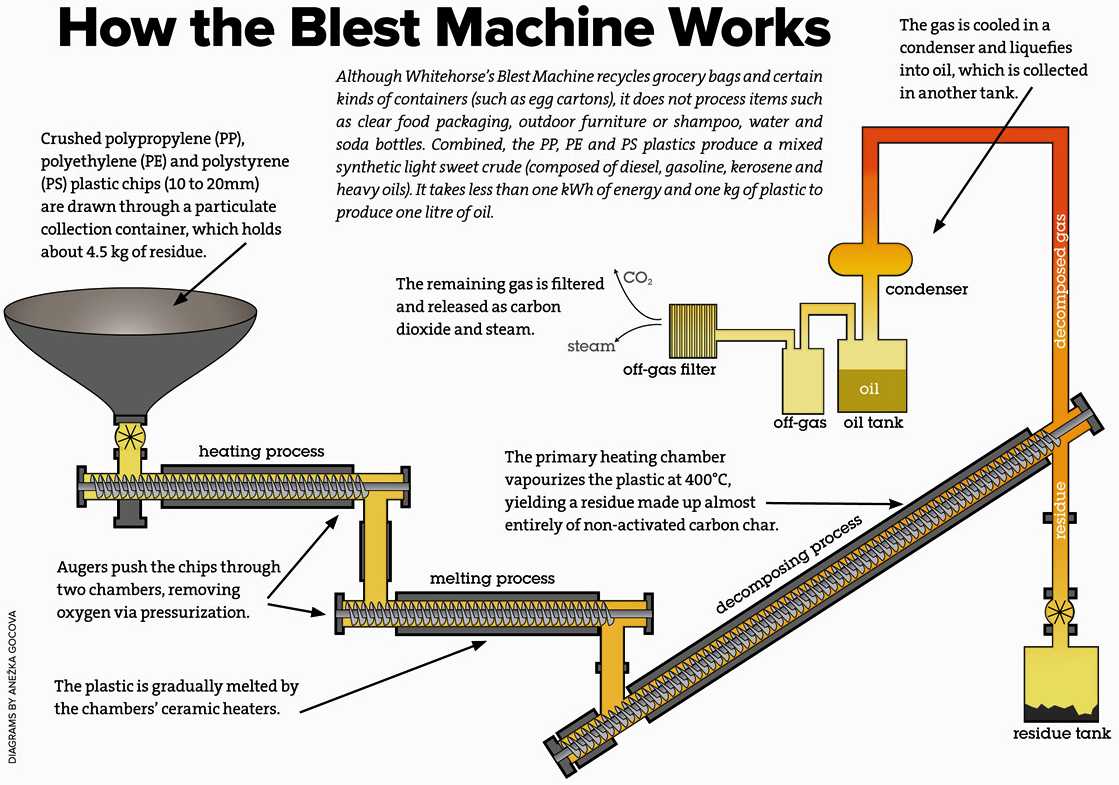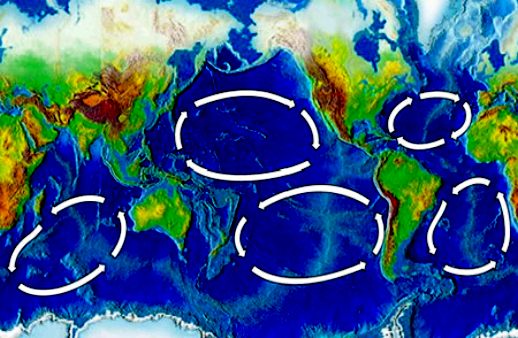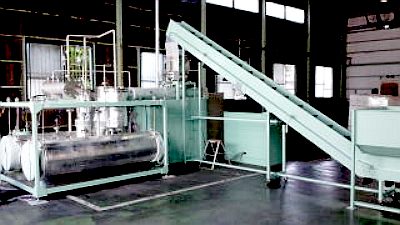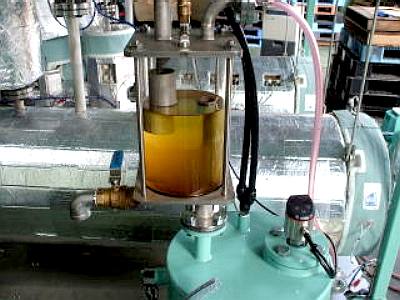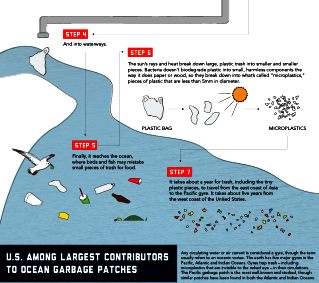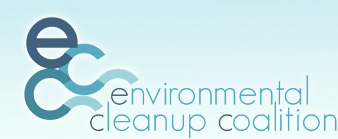|
CONVERTING OCEAN PLASTIC WASTE TO OIL
|
||
|
The wonderful invention of plastics has spawned a huge problem that we are struggling to solve. We find ourselves on top of increasing plastic mountains in our oceans. But now there is a chance of recovering some of the energy locked in this waste, while also removing the contaminants from the sea.
Akinori Ito explains how to use one of his machines to an audience. The bag of plastic in his hand will go into the machine behind him and come out as oil. It's virtually magic, in days of old he might have been in trouble as an alchemist.
HOW IS THIS POSSIBLE?
The game changer for the non-profit
organizations that are doing their best to find a cure for ocean pollution
was discovering Blest, a Japanese company that makes and markets a plastics-to-light crude oil
converter, using a process known as pyrolysis. This converter can produce a gallon of fuel from eight pounds of plastic waste with no toxic air emissions because the plastics are only heated for distillation into fuels, and not incinerated. The only resulting emissions are water vapor and carbon dioxide.
It sounds too good to be true, but it is a fact based possibility.
Such projects are not generally commercially viable but may eventually gain support from philanthropic and corporate organizations, for the sake of the environment.
WHAT IS PYROLYSIS?
Pyrolysis is a thermochemical decomposition of organic material at elevated temperatures in the absence of oxygen (or any halogen). The word is coined from the Greek-derived elements pyro "fire" and lysis "separating".
Pyrolysis is usually the first chemical reaction that occurs in the burning of many solid organic fuels, like wood, cloth, and paper, and also of some kinds of plastic. In a wood fire, the visible flames are not due to combustion of the wood itself, but rather of the gases released by its pyrolysis, whereas the flame-less burning of a solid, called smouldering, is the combustion of the solid residue (char or charcoal) left behind by pyrolysis.
Once widely known, such technology could spawn a Micro Industry, by way of example in India. Scavenging rag-pickers, the most vulnerable and the economically weaker section of the Indian society walk the streets of Mumbai and pick-up the rubbish strewn around posh houses, converting waste plastic into wealth - in the process helping to stop plastic getting to the ocean.
London's mayor, Boris Johnson has said something related about Municipal corporations, as in they should be doing something about recycling the "filth." But the real change will come when we add “value” to the filth especially plastic waste.
There is evidence of this in Navsari near the city of Surat itself. A young girl had been able to create a small system spending a few thousand rupees, which could convert 3kg of plastic waste to around 2 litre of liquid fuel. The girl had done this as a school project, and is one of the most fitting examples of Women Empowerment and Climate Change abatement wrapped into one.
RECYCLING
This is a superb diagram to explain the workings of a Blest converter
Blest’s conversion technology is considered safer because it uses a temperature controlling electric heater rather than flame. The machines are able to process polyethylene, polystyrene and polypropylene but not PET bottles. The result is a crude gas that can fuel things like generators or stoves and, when refined, can even be pumped into a car, a boat or motorbike. One kilogram of
plastic produces almost one liter of oil. To convert that amount takes about 1
kW of electricity, which is approximately ¥20 or 20 cents’ worth.
Hydrocarbon gases (Methane, Ethane, Propane, Butane and so on) are generated, in the conversion process So, Blest install "Hydrocarbon Gas Filters" into their machines, which decompose hydrocarbon gases into harmless materials (Water and Carbon Dioxide).
Mr. Ito is quoted as saying: " The fundamentals of plastic to oil conversion are not that complex. When heated, plastic changes to liquid and if heated further it vaporizes. If you cool the gas with water, oil can be recovered. I thought that by making use of Japanese technology, it should be easy to convert plastic to oil. This was the start of our business." Contact Blest directly at info@blest.co.jp
One of the small Blest conversion machines that is useful for giving demonstrations.
Akinori Ito converts plastic to oil and schoolchildren into believers
The five main ocean gyres have become plastic garbage patches, but also represent a significant oil store, if the technology to extract that energy is not too expensive to set up treatment plants for recycling, then ocean going robots may provide the answer as to how to get all that waste plastic to a Blest converter.
RT RECYCLING TECHNOLOGIES
Ecomachines incubato, the seed fund and accelerator for startups in the energy and resource efficiency space, invested in Recycling Technologies, a company that recycles plastic waste into a clean heavy fuel oil alternative - kicking that project into touch. Recycling Technologies produces machines that convert Mixed Plastic Waste, destined for landfill or incineration, into an oil that may be sold or used as fuel in localised on-demand heat and power facilities.
In the first phase of the process, the WarwickFBR™ system shreds and dries the Mixed Plastic Waste [MPW]. It then injects blended product into a fluidised bed where, in an oxygen depleted environment the long hydrocarbon chains in the polymers are broken down by Pyrolysis to form an energy rich gas. This gas is then carefully filtered to remove contamination and cooled to provide a type of heavy fuel oil. This fuel - PlaxOil - can be resold into the hydrocarbons market.
RT CONTACTS
ILLINOIS - 2/12/2014 PLASTIC SHOPPING BAGS MAKE FINE DIESEL FUEL
Plastic shopping bags, an abundant source of litter on land and at sea, can be converted into diesel, natural gas and other useful petroleum products, researchers report. Diana Yates, Life Sciences Editor
- 217-333-5802; diya@illinois.edu
ILLINOIS - Brajendra Kumar Sharma, center, a senior research scientist at the Illinois Sustainable Technology Center at the U. of I., with research chemist Dheeptha Murali, left, and process chemist Jennifer Deluhery, converted plastic shopping bags into diesel fuel.
JUNE 2013 - EUROPE ON PLASTIC WASTE TREATMENT
In a statement, the Confederation of European Waste-to-Energy Plants (CEWEP) gave its answers to all 26 of the questions posed by
a green paper, and gave particular credence to moves towards ending the
land-filling of plastic waste and ensuring that it is treated higher up the waste hierarchy.
One of the larger Blest machines that can operate on an industrial scale
This is how your plastic trash ends up in the ocean, according to the Huffington Post. 270,000 tons of waste could yield 50,000,000 million gallons of oil, worth around $71 million dollars - even at the rate of $60 dollars a barrel, the price as of December 2014.
ACIDIFICATION - ADRIATIC - ARCTIC - ATLANTIC - BALTIC - BERING - CARIBBEAN - CORAL - EAST CHINA ENGLISH CH - GOC - GULF MEXICO - INDIAN - IRC - MEDITERRANEAN - NORTH SEA - PACIFIC - PERSIAN GULF - SEA JAPAN STH
CHINA - PLASTIC
- PLANKTON - PLASTIC
OCEANS - SEA
LEVEL RISE - UNCLOS
- UNEP
WOC
- WWF
BENIN - This plastic waste will be dumped in the ocean
LINKS & REFERENCE
Blest Japan Plastic to Oil converters Environment
Japanese Government Blest
Inhabitat 19 year old student develops cleanup array to remove 7250000 tons plastic-from worlds oceans The mind unleashed author Tmuorg Plastic
Boards 5 Gyres - Understanding Plastic Marine Pollution Wind Driven Surface Currents: Gyres SIO 210: Introduction to Physical Oceanography - Global circulation SIO 210: Introduction to Physical Oceanography - Wind-forced circulation notes SIO 210: Introduction to Physical Oceanography - Lecture 6 Physical Geography - Surface and Subsurface Ocean Currents North Pacific Gyre Oscillation — Georgia Institute of Technology Education National Geographic ocean gyre News Illinois plastic bags conversion to_oil Brajendra Kumar Sharma http://news.illinois.edu/news/14/0212bags_oil_BrajendraKumarSharma.html http://recyclingtechnologies.co.uk/ http://www.recycle.co.uk/ http://en.wikipedia.org/wiki/Pyrolysis http://www.huffingtonpost.com/2014/04/22/plastic-ocean-garbage_n_5191294.html http://www.huffingtonpost.com/miyoko-sakashita/our-oceans-awash-in-toxic_b_6312164.html http://www.env.go.jp/earth/coop/eco-csrjapan/en/blest.html
http://www.blest.co.jp/index-english.html http://www.greatrecovery.org.uk/plastic-its-a-lovehate-thing/ http://www.greatrecovery.org.uk/ http://www.epsrc.ac.uk/ http://themindunleashed.org/author/tmuorg http://seaplexscience.com/ http://abundantseas.org/ http://www.gyrecleanup.org/cleanup-plan/ http://education.nationalgeographic.co.uk/education/encyclopedia/ocean-gyre/?ar_a=1 http://www.plasticboards.com
SEAVOLUTION - A non-polluting vessel such as the Bluefish ZCC concept above could be an ideal base machine when it comes to filtering garbage from the world's ocean gyres. The Bluefish is a robotic ocean workhorse that is based on a stable SWASH hull. This design uses no diesel fuel to cruise the oceans autonomously (COLREGS compliant) at between 7-10 knots 24/7 and 365 days a year as required. With such awesome power generating capability, a ZCC can be adapted to extract plastic waste from ocean garbage patches. Several of these cleaners operating as Atlantic, Indian and Pacific ocean fleets could make such conservation measures cost effective, and even potentially attractive to governments around the world - for the health of the world. Recovered plastic could be processed to produce oil, energy or recycled products. Better than letting fish and seabirds eat the waste and kill themselves, and who knows how that may affect us, where seafood is an essential resource for mankind.
|
||
|
This
website is Copyright © 2015 Bluebird Marine Systems Limited.
The names Bluebird, Bluefish™,
SeaNet™,
SeaVax™,
and the blue bird in flight
|
